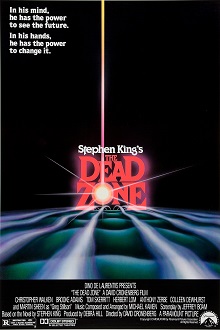
David Paul Cronenberg is a Canadian film director and screenwriter. He is a principal originator of the body horror genre, with his films exploring visceral bodily transformation, infectious diseases, and the intertwining of the psychological, physical, and technological. Cronenberg is best known for exploring these themes through sci-fi horror films such as Shivers (1975), Scanners (1981), Videodrome (1983) and The Fly (1986), though he has also directed dramas, psychological thrillers and gangster films.

Christopher Walken is an American actor. Prolific in film, television, and on stage, Walken is the recipient of numerous accolades. He has earned an Academy Award, a BAFTA Award, a Screen Actors Guild Award, as well as nominations for two Primetime Emmy Awards and two Tony Awards. His films have grossed more than $1.6 billion in the United States alone.

Naked Lunch is a 1991 surrealist science fiction drama film written and directed by David Cronenberg and starring Peter Weller, Judy Davis, Ian Holm, and Roy Scheider. It is an adaptation of William S. Burroughs's 1959 novel of the same name, and an international co-production of Canada, Britain, and Japan.
The Dead Zone may refer to:
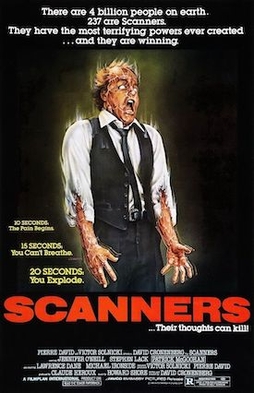
Scanners is a 1981 Canadian science fiction horror film written and directed by David Cronenberg and starring Stephen Lack, Jennifer O'Neill, Michael Ironside, and Patrick McGoohan. In the film, "scanners" are psychics with unusual telepathic and telekinetic powers. ConSec, a purveyor of weaponry and security systems, searches out scanners to use them for its own purposes. The film's plot concerns the attempt by Darryl Revok (Ironside), a renegade scanner, to wage a war against ConSec. Another scanner, Cameron Vale (Lack), is dispatched by ConSec to stop Revok.
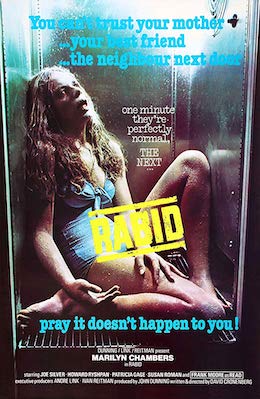
Rabid is a 1977 independent body horror film written and directed by David Cronenberg. An international co-production of Canada and the United States, the film stars Marilyn Chambers in the lead role, supported by Frank Moore, Joe Silver, and Howard Ryshpan. Chambers plays a woman who, after being injured in a motorcycle accident and undergoing a surgical operation, develops an orifice under one of her armpits that hides a phallic/clitoral stinger she uses to feed on people's blood. Those she bites become infected, and then feed upon others, spreading the disease exponentially. The result is massive chaos, starting in the Quebec countryside, and ending up in Montreal. Rabid made $1 million in Canada, making it one of the highest-grossing Canadian films of all time. A remake of the same name, directed by Jen and Sylvia Soska, was released in 2019.
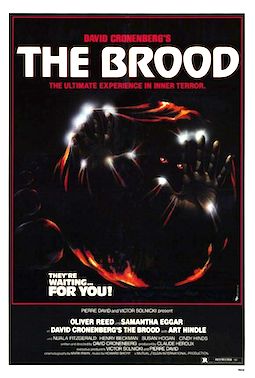
The Brood is a 1979 Canadian psychological body horror film written and directed by David Cronenberg and starring Oliver Reed, Samantha Eggar, and Art Hindle. Its plot follows a man and his mentally ill ex-wife, who has been sequestered by a psychiatrist known for his controversial therapy techniques. A series of brutal unsolved murders serves as the backdrop for the central narrative.
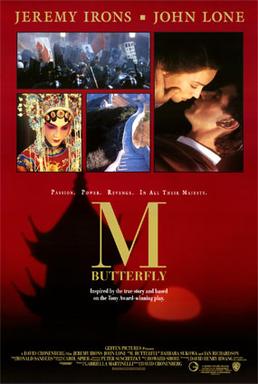
M. Butterfly is a 1993 American romantic drama film directed by David Cronenberg. The screenplay was written by David Henry Hwang based on his play of the same name. The film stars Jeremy Irons and John Lone, with Ian Richardson, Barbara Sukowa, and Annabel Leventon. The story is loosely based on true events which involved French diplomat Bernard Boursicot and Chinese opera singer Shi Pei Pu.

Videodrome is a 1983 Canadian science fiction body horror film written and directed by David Cronenberg and starring James Woods, Sonja Smits, and Debbie Harry. Set in Toronto during the early 1980s, it follows the CEO of a small UHF television station who stumbles upon a broadcast signal of snuff films. Layers of deception and mind-control conspiracy unfold as he attempts to uncover the signal's source, complicated by increasingly intense hallucinations that cause him to lose his grasp on reality.
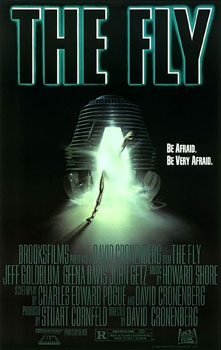
The Fly is a 1986 American science fiction horror film directed and co-written by David Cronenberg. Produced by Brooksfilms and distributed by 20th Century Fox, the film stars Jeff Goldblum, Geena Davis and John Getz. Loosely based on George Langelaan's 1957 short story of the same name and the 1958 film of the same name, The Fly tells of an eccentric scientist who, after one of his experiments goes wrong, slowly turns into a fly-hybrid creature. The score was composed by Howard Shore and the make-up effects were created by Chris Walas, along with makeup artist Stephan Dupuis.

Michael Antonio Cimino was an American film director, screenwriter, producer and author. Notorious for his obsessive attention to detail and determination for perfection, Cimino achieved fame with The Deer Hunter (1978), which won five Academy Awards, including Best Picture and Best Director.

Castle Rock is a fictional town appearing in Stephen King's fictional Maine topography, providing the setting for a number of his novels, novellas, and short stories. Castle Rock first appeared in King's 1979 novel The Dead Zone and has since been referred to or used as the primary setting in many other works by King.

Dead Ringers is a 1988 psychological thriller film starring Jeremy Irons in a dual role as identical twin gynecologists. David Cronenberg directed and co-wrote the screenplay with Norman Snider. Their script was based on the lives of Stewart and Cyril Marcus and on the novel Twins by Bari Wood and Jack Geasland, a "highly fictionalized" version of the Marcuses' story.
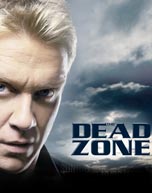
The Dead Zone, also known as Stephen King's The Dead Zone is a science-fiction drama television series starring Anthony Michael Hall as Johnny Smith, who discovers he has developed psychic abilities after a coma. The show, credited as "based on characters" from Stephen King's 1979 novel of the same name, first aired in 2002, and was produced by Lionsgate Television and Paramount Network Television for the USA Network.
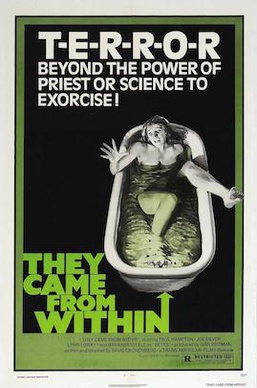
Shivers, also known as The Parasite Murders and They Came from Within, and, for Canadian distribution in French, Frissons, is a 1975 Canadian science fiction body horror film written and directed by David Cronenberg and starring Paul Hampton, Lynn Lowry, and Barbara Steele.

Crash is a 1996 Canadian drama film written, produced and directed by David Cronenberg, based on J. G. Ballard's 1973 novel of the same name. Starring James Spader, Deborah Kara Unger, Elias Koteas, Holly Hunter and Rosanna Arquette, it follows a film producer who, after surviving a car crash, becomes involved with a group of symphorophiliacs who are aroused by car crashes and tries to rekindle his sexual relationship with his wife.

Fast Company is a 1979 Canadian action film directed by David Cronenberg and starring William Smith, John Saxon, Claudia Jennings and Nicholas Campbell. It was written by Phil Savath, Courtney Smith, Alan Treen and Cronenberg. It was primarily filmed at Edmonton International Speedway, in addition to other locations in Edmonton, Alberta, and Western Canada.
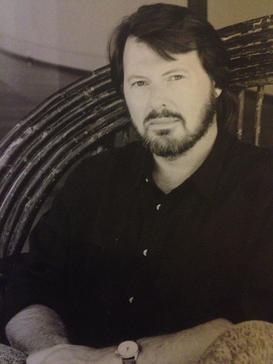
Jeffrey David Boam was an American screenwriter and film producer. He is known for writing the screenplays for The Dead Zone, Indiana Jones and the Last Crusade, Innerspace, The Lost Boys, and Lethal Weapon 2 and 3. Boam's films had a cumulative gross of over US$1 billion. He was educated at Sacramento State College and UCLA. Boam died of heart failure on January 26, 2000, at age 53.

The Dead Zone is a science fiction thriller novel by Stephen King published in 1979. The story follows Johnny Smith, who awakens from a coma of nearly five years and, apparently as a result of brain damage, now experiences clairvoyant and precognitive visions triggered by touch. When some information is blocked from his perception, Johnny refers to that information as being trapped in the part of his brain that is permanently damaged, "the dead zone." The novel also follows a serial killer in Castle Rock, and the life of rising politician Greg Stillson, both of whom are evils Johnny must eventually face.
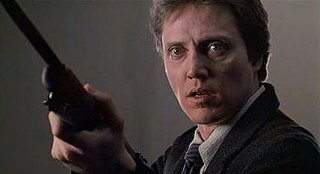
John Smith is a fictional character and the protagonist of Stephen King's 1979 novel The Dead Zone. He possesses psychic abilities that allow him to see moments of the future and past, usually triggered by touching objects or a person related to that future. He is portrayed by Christopher Walken in the 1983 film and Anthony Michael Hall in the 2002 television series. Paste Magazine has ranked Johnny Smith the sixth out of eight creepiest Christopher Walken performances.
